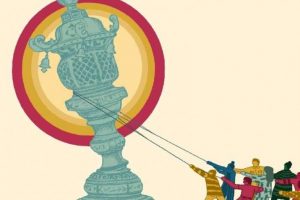
On the 10th day of every month of the Tibetan calender, Vajrayana Buddhists pay homage to Guru Padmasambhava (lotus-born), more popularly known as Guru Rinpoche. The day is observed by making offerings (Tsok) prepared from barley, sugar and butter, which are carefully constructed into a Torma (a figure of a deity made of butter and flour). This is followed by the recital of devotional puja toward the guru in either a short form, completed in an hour, or a full recital spanning the entire day. Blessed morsels of the tsok are then eaten after the puja is complete. In larger Vajrayana communities, other festivities include ritual performances. In these, Guru Rinpoche’s initial taming of the forces of the Tibetan landscape and its local spirits are re-enacted in elaborate operatic performances and traditional dance. For followers of the Nyingma tradition, meat and alcohol are typically consumed on this day.
This month, I paid special attention to a small copper figure of the Guru that has always taken pride of place in my own household shrine. This devotional object conveyed to me the high esteem and the many aspects the tantric master enjoys. I meditated a while upon the effigy in front of me.
Observing the fine decorative details engraved into the gilt copper surface, I remembered the cakravartin (Dharma king) Padmasambhava, a Buddhist spiritual leader, richly dressed in robes of finely embroidered textiles with large ear ornaments hanging from his distended earlobes.
I then noted the guru’s attributes. In his lower hand, a skull cap (kapala) symbolizing detachment and the taming of the mind through meditation. Held in his raised hand, is a vajra (thunderbolt sceptre) symbolizing the crystal-clarity of pure Buddhist thought and the guru’s deep knowledge of the Vajrayana. I remembered the historical Padmasambhava, who left behind a life of luxury bestowed upon him for the attainment of supreme spiritual knowledge.
I then directed my focus on the subtle modeling of the figures limbs, seated in the cross-legged meditation posture. The master attained an advanced level of practice, developed away from formal monasticism and strongly incorporating mysticism and nature spirit worship.
Atop his head was the distinctive cloth cap of the Nyingma Order bringing to mind the great patron saint Padmasambhava, Indian master and teacher of Buddhist tantric practices. I became conscious of the independent tantric tradition of Buddhism to which Vajrayana belongs. This tradition is said to have been introduced to Tibet by the guru himself, who traveled to Tibet in the late 8th century CE and became the founding lineage holder of the Nyingma tradition.
Lastly, my gaze met the exquisitely rendered face of the familiar effigy with his open expression – attentive and spiritually alive. The guru appeared to gaze tenderly back, divine yet reachable. Transcendent yet grounded in the world. It was then that I remembered Padmasambhava. I was reminded that every image created of the guru was beyond all else, an ultimate representation of the perfect teacher.
The potency of Guru Rinpoche’s presence among Vajrayana followers today belongs to the tradition of establishing a strong teacher-student relationship established by the guru all those years ago. The premise is simple; that when it comes to the dharma, students must approach gradually and with the mindfulness needed to build strong foundations. For most individuals, this can only be achieved with the guidance of a teacher, who, according to Vajrayana, is the source of all blessings. If care is taken to practice what the teacher advises, progress is made.
With the guidance of a teacher, knowledge is contextualised and revealed slowly, only when the student is deemed ready to receive it. The process of reflection and inquiry helps safeguard us from misuse and misinterpretation of the tantras, allowing for the student to ask questions and address any doubt. Just as the diamond represents the Vajrayana tradition – no amount of grinding, weathering or beating can damage its purity – so the dharma remains infallible in its qualities of truth and clarity under testing and fire.
Guru Rinpoche day is a day we can remember all our teachers and remind ourselves of the qualities we must strive for as students of the Dharma.








